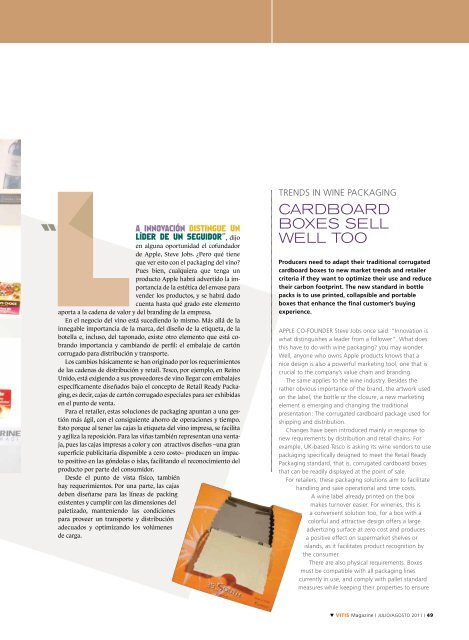VINOS DE PARRAS ANTIGUAS - Vitis Magazine
VINOS DE PARRAS ANTIGUAS - Vitis Magazine
VINOS DE PARRAS ANTIGUAS - Vitis Magazine
You also want an ePaper? Increase the reach of your titles
YUMPU automatically turns print PDFs into web optimized ePapers that Google loves.
LA INNOVACIóN DISTINguE uN<br />
Lí<strong>DE</strong>r <strong>DE</strong> uN SEguIDOr”, dijo<br />
en alguna oportunidad el cofundador<br />
de Apple, Steve Jobs. ¿Pero qué tiene<br />
que ver esto con el packaging del vino?<br />
Pues bien, cualquiera que tenga un<br />
producto Apple habrá advertido la importancia<br />
de la estética del envase para<br />
vender los productos, y se habrá dado<br />
cuenta hasta qué grado este elemento<br />
aporta a la cadena de valor y del branding de la empresa.<br />
En el negocio del vino está sucediendo lo mismo. Más allá de la<br />
innegable importancia de la marca, del diseño de la etiqueta, de la<br />
botella e, incluso, del taponado, existe otro elemento que está cobrando<br />
importancia y cambiando de perfil: el embalaje de cartón<br />
corrugado para distribución y transporte.<br />
Los cambios básicamente se han originado por los requerimientos<br />
de las cadenas de distribución y retail. Tesco, por ejemplo, en Reino<br />
Unido, está exigiendo a sus proveedores de vino llegar con embalajes<br />
específicamente diseñados bajo el concepto de Retail Ready Packaging,<br />
es decir, cajas de cartón corrugado especiales para ser exhibidas<br />
en el punto de venta.<br />
Para el retailer, estas soluciones de packaging apuntan a una gestión<br />
más ágil, con el consiguiente ahorro de operaciones y tiempo.<br />
Esto porque al tener las cajas la etiqueta del vino impresa, se facilita<br />
y agiliza la reposición. Para las viñas también representan una ventaja,<br />
pues las cajas impresas a color y con atractivos diseños –una gran<br />
superficie publicitaria disponible a cero costo– producen un impacto<br />
positivo en las góndolas o islas, facilitando el reconocimiento del<br />
producto por parte del consumidor.<br />
Desde el punto de vista físico, también<br />
hay requerimientos. Por una parte, las cajas<br />
deben diseñarse para las líneas de packing<br />
existentes y cumplir con las dimensiones del<br />
paletizado, manteniendo las condiciones<br />
para proveer un transporte y distribución<br />
adecuados y optimizando los volúmenes<br />
de carga.<br />
tRENDs iN WiNE PaCKagiNg<br />
CARDbOARD<br />
bOxES SELL<br />
wELL TOO<br />
Producers need to adapt their traditional corrugated<br />
cardboard boxes to new market trends and retailer<br />
criteria if they want to optimize their use and reduce<br />
their carbon footprint. The new standard in bottle<br />
packs is to use printed, collapsible and portable<br />
boxes that enhance the final customer’s buying<br />
experience.<br />
aPPlE Co-fouN<strong>DE</strong>R steve jobs once said: “innovation is<br />
what distinguishes a leader from a follower”. What does<br />
this have to do with wine packaging? you may wonder.<br />
Well, anyone who owns apple products knows that a<br />
nice design is also a powerful marketing tool, one that is<br />
crucial to the company’s value chain and branding.<br />
the same applies to the wine industry. Besides the<br />
rather obvious importance of the brand, the artwork used<br />
on the label, the bottle or the closure, a new marketing<br />
element is emerging and changing the traditional<br />
presentation: the corrugated cardboard package used for<br />
shipping and distribution.<br />
Changes have been introduced mainly in response to<br />
new requirements by distribution and retail chains. for<br />
example, uK-based tesco is asking its wine vendors to use<br />
packaging specifically designed to meet the Retail Ready<br />
Packaging standard, that is, corrugated cardboard boxes<br />
that can be readily displayed at the point of sale.<br />
for retailers, these packaging solutions aim to facilitate<br />
handling and save operational and time costs.<br />
a wine label already printed on the box<br />
makes turnover easier. for wineries, this is<br />
a convenient solution too, for a box with a<br />
colorful and attractive design offers a large<br />
advertizing surface at zero cost and produces<br />
a positive effect on supermarket shelves or<br />
islands, as it facilitates product recognition by<br />
the consumer.<br />
there are also physical requirements. Boxes<br />
must be compatible with all packaging lines<br />
currently in use, and comply with pallet standard<br />
measures while keeping their properties to ensure<br />
▼ <strong>Vitis</strong> <strong>Magazine</strong> l julio/agosto 2011 l 49






